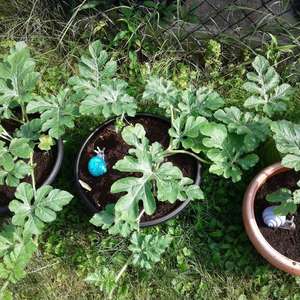文章
Miss Chen
2018年07月08日

Description: This herbaceous plant is a biennial or short-lived perennial that becomes 4-8' tall. The stout central stem is unbranched or sparingly branched; it is light green, terete, and more or less hairy. The blades of the alternate leaves are up to 8" long and across; they are palmately lobed (with 3-7 blunt lobes each) and crenate along their margins. Each leaf blade is orbicular or oval in outline and indented at the base where the petiole joins the blade. The upper surface of each leaf blade is medium green, slightly pubescent to hairless, and wrinkled from fine veins; the lower surface is light green and pubescent. The petioles of the leaves are as long or a little longer than their blades; they are light green and hairy.
The central stem terminates in a spike-like raceme of flowers; axillary flowers are produced from the axils of the upper leaves as well. These flowers occur individually or in small clusters along the central stem; they nod sideways from short hairy pedicels. Each flower spans about 3-5" when it is fully open; it has 5 petals, 5 sepals, 6-9 sepal-like bracts, and a columnar structure in the center with the reproductive organs (stamens toward the tip, thread-like stigmas below). The overlapping petals provide the flower with a funnelform shape; they are usually some shade of white, pink, or purplish red. The sepals are light green, ovate, and much smaller than the petals. The bracts of each flower are located underneath the sepals; they are light green, hairy, ovate, and joined together at the base. The blooming period occurs from mid-summer into the fall; a colony of plants will bloom for about 2 months. Each flower is replaced by a fruit containing a ring of 15-20 seeds (technically, a schizocarp). These seeds are oval, flattened, and notched on one side. The root system consists of a taproot. This plant spreads by reseeding itself.Central Stem & Flowerbud
Cultivation: The preference is full to partial sun, moist to mesic conditions, and a fertile loamy soil. Lower leaves will wither away during hot dry weather. Hollyhock is vulnerable to foliar disease, including rust.

Range & Habitat: The non-native Hollyhock occasionally escapes from cultivation, but it rarely persists. Escaped plants have been collected primarily in NE and east central Illinois (see Distribution Map). Habitats include areas along railroads, roadsides, vacant lots, and waste areas, especially in urban areas. Areas with a history of disturbance are preferred. Because of the showy flowers, Hollyhock is often cultivated in gardens. It is native to Eurasia.
Faunal Associations: The flowers are cross-pollinated by several kinds of bees. Various insects feed on the leaves and other parts of Hollyhock. These include caterpillars of Pyrgus communis (Common Checkered Skipper), caterpillars of the butterflies Vanessa cardui (Painted Lady) and Strymon melinus (Gray Hairstreak), and caterpillars of such moths as Acontia aprica (Exposed Bird-Dropping Moth), Anomis erosa (Yellow Scallop Moth), Autographa precationis (Common Looper Moth), Mamestra configurata (Bertha Armyworm), and Astrotischeria omissa (Bouseman et al., 2006; Wagner, 2005; Covell, 1984/2005; Needham et al., 1928). Other insects that feed on Hollyhock include both adults and larvae of Apion longirostre (Hollyhock Weevil), adults of Popillia japonica (Japanese Beetle), Acyrthosiphon malvae (Geranium Aphid) and Aphis gossypii (Cotton Aphid), Brooksetta althaeae (Hollyhock Plant Bug), and larvae of the flies Calycomyza malvae and Melanagromyza hicksi (Cranshaw, 2004; personal observation; Blackman & Eastop, 2013; Pepper, 1965; Knight, 1941; Spencer & Steyskal, 1986). The foliage is palatable to cattle and other hoofed mammalian herbivores.
Photographic Location: The photograph of the flower was taken at The Arboretum in Urbana, Illinois; the photographs of the stem and leaf were taken at a flower garden of the same city.

Comments: The meaning of the common name is probably 'Holy Mallow.' Hollyhock is one of the taller members of the Mallow family. It superficially resembles one of the native Hibiscus spp. (Rose Mallows), which are perennial wetland plants. Hollyhock differs in having floral bracts that are ovate, while a Rose Mallow has floral bracts that are narrowly linear. The structures of their fruits also differ: the fruit of Hollyhock consists of a ring of seeds, while the fruit of Rose Mallow is a 5-celled capsule. Some of the taller Malva spp. (Mallows) also resemble Hollyhock, but they have only 1-3 bracts per flower; Hollyhock has 6-9 bracts per flower. An alternative scientific name for this species is Althaea rosea.
The central stem terminates in a spike-like raceme of flowers; axillary flowers are produced from the axils of the upper leaves as well. These flowers occur individually or in small clusters along the central stem; they nod sideways from short hairy pedicels. Each flower spans about 3-5" when it is fully open; it has 5 petals, 5 sepals, 6-9 sepal-like bracts, and a columnar structure in the center with the reproductive organs (stamens toward the tip, thread-like stigmas below). The overlapping petals provide the flower with a funnelform shape; they are usually some shade of white, pink, or purplish red. The sepals are light green, ovate, and much smaller than the petals. The bracts of each flower are located underneath the sepals; they are light green, hairy, ovate, and joined together at the base. The blooming period occurs from mid-summer into the fall; a colony of plants will bloom for about 2 months. Each flower is replaced by a fruit containing a ring of 15-20 seeds (technically, a schizocarp). These seeds are oval, flattened, and notched on one side. The root system consists of a taproot. This plant spreads by reseeding itself.Central Stem & Flowerbud
Cultivation: The preference is full to partial sun, moist to mesic conditions, and a fertile loamy soil. Lower leaves will wither away during hot dry weather. Hollyhock is vulnerable to foliar disease, including rust.

Range & Habitat: The non-native Hollyhock occasionally escapes from cultivation, but it rarely persists. Escaped plants have been collected primarily in NE and east central Illinois (see Distribution Map). Habitats include areas along railroads, roadsides, vacant lots, and waste areas, especially in urban areas. Areas with a history of disturbance are preferred. Because of the showy flowers, Hollyhock is often cultivated in gardens. It is native to Eurasia.
Faunal Associations: The flowers are cross-pollinated by several kinds of bees. Various insects feed on the leaves and other parts of Hollyhock. These include caterpillars of Pyrgus communis (Common Checkered Skipper), caterpillars of the butterflies Vanessa cardui (Painted Lady) and Strymon melinus (Gray Hairstreak), and caterpillars of such moths as Acontia aprica (Exposed Bird-Dropping Moth), Anomis erosa (Yellow Scallop Moth), Autographa precationis (Common Looper Moth), Mamestra configurata (Bertha Armyworm), and Astrotischeria omissa (Bouseman et al., 2006; Wagner, 2005; Covell, 1984/2005; Needham et al., 1928). Other insects that feed on Hollyhock include both adults and larvae of Apion longirostre (Hollyhock Weevil), adults of Popillia japonica (Japanese Beetle), Acyrthosiphon malvae (Geranium Aphid) and Aphis gossypii (Cotton Aphid), Brooksetta althaeae (Hollyhock Plant Bug), and larvae of the flies Calycomyza malvae and Melanagromyza hicksi (Cranshaw, 2004; personal observation; Blackman & Eastop, 2013; Pepper, 1965; Knight, 1941; Spencer & Steyskal, 1986). The foliage is palatable to cattle and other hoofed mammalian herbivores.
Photographic Location: The photograph of the flower was taken at The Arboretum in Urbana, Illinois; the photographs of the stem and leaf were taken at a flower garden of the same city.

Comments: The meaning of the common name is probably 'Holy Mallow.' Hollyhock is one of the taller members of the Mallow family. It superficially resembles one of the native Hibiscus spp. (Rose Mallows), which are perennial wetland plants. Hollyhock differs in having floral bracts that are ovate, while a Rose Mallow has floral bracts that are narrowly linear. The structures of their fruits also differ: the fruit of Hollyhock consists of a ring of seeds, while the fruit of Rose Mallow is a 5-celled capsule. Some of the taller Malva spp. (Mallows) also resemble Hollyhock, but they have only 1-3 bracts per flower; Hollyhock has 6-9 bracts per flower. An alternative scientific name for this species is Althaea rosea.
0
0
文章
Miss Chen
2018年07月08日

Description: This herbaceous perennial plant is 4-12" tall and unbranched, consisting of a rosette of leaves and a flowering stalk. The basal leaves are up to 3" long and 1" across. They are evergreen or semi-evergreen, obovate (spoon-shaped), and nearly hairless. Their margins are crenate and slightly undulate. The flowering stalk is 4-angled and slightly pubescent or hairy. The opposite leaves along this stalk are similar to the basal leaves, except that they are smaller in size and ovate. The flowers occur in a whorled spike along the upper half of the leafy stalk. They are produced in abundance and densely distributed along this spike. Each tubular flower is about 1/2–2/3" (12-17 mm.) in length, consisting of a 2-lipped corolla and a green calyx with 5 teeth. The corolla is usually various shades of blue-violet, and less often pink or white. There are dark blue-violet lines that lead toward the throat of the corolla; they function as nectar guides. The upper lip of the corolla is truncated and very small, while the large lower lip has 3 rounded lobes. The middle lobe of the lower lip is notched at its tip and the largest in size. The outer surface of the corolla behind the lobes is conspicuously hairy; this causes the flower buds to appear hairy.
The blooming period occurs during the spring and lasts about 2-3 weeks. Each flower is replaced by 4 nutlets that are oval-shaped and pitted across the surface. The root system consists of a crown of fibrous roots. Green stolons up to 12" long are produced from the rosette of basal leaves. They are largely naked, except for a few small leaves that are narrowly ovate. These stolons often form new plantlets by rooting at their tips. Carpet Bugle can reproduce by seeds or vegetatively by means of these stolons; it often forms colonies.
Cultivation: The preference is partial sun, slightly moist to mesic conditions, and a fertile loamy soil that is somewhat acidic. If the soil is poorly drained and soggy, crown rot can develop and spread rapidly. In sandy soil, the roots are occasionally attacked by nematodes.

Range & Habitat: The non-native Carpet Bugle can escape from cultivation in gardens, but it is still uncommon in the wild, occurring in NE Illinois and Jackson County in southern Illinois (see Distribution Map). Habitats include partially shaded areas of lawns, edges of yards, partially shaded areas along foundations of buildings, nursery plots, and edges of woodlands. This plant is occasionally used as a ground cover because of its evergreen leaves and low spreading habit, but it is potentially invasive of natural areas. In Eurasia, where it is native, this plant occurs in partially shaded areas of deciduous woodlands, thickets, or meadows; the flowers bloom before the leaves of the trees have become fully developed.
Faunal Associations: The flowers are pollinated by bumblebees and other long-tongued bees. According to sources within the horticulture industry, the foliage is rarely bothered by rabbits and deer.

Photographic Location: The photographs were taken underneath a tree at Dave Monk's postage stamp prairie in Champaign, Illinois, and along the side of a house in NW Ohio.
Comments: Different cultivars of Carpet Bugle are available through the horticultural industry that can vary considerably in the color of their flowers and foliage. The only other Ajuga sp. that has naturalized in Illinois is Ajuga genevensis (Geneva Bugle). This species is slightly taller with stems and leaves that are more hairy than Carpet Bugle; it also doesn't produce stolons. Carpet Bugle is easy to distinguish from other members of the Mint family because of the following combination of features: 1) Its blue-violet flowers are ½" in length or slightly larger, 2) the upper lip of the corolla is truncated and quite short, 3) the flowers occur in a terminal whorled spike, 4) the flowers bloom during the spring on stalks that are 1' tall or less, and 5) above ground stolons are produced in abundance from the rosette of basal leaves. This latter characteristic is especially useful in identifying this species because very few members of the Mint family produce above-ground stolons.
The blooming period occurs during the spring and lasts about 2-3 weeks. Each flower is replaced by 4 nutlets that are oval-shaped and pitted across the surface. The root system consists of a crown of fibrous roots. Green stolons up to 12" long are produced from the rosette of basal leaves. They are largely naked, except for a few small leaves that are narrowly ovate. These stolons often form new plantlets by rooting at their tips. Carpet Bugle can reproduce by seeds or vegetatively by means of these stolons; it often forms colonies.
Cultivation: The preference is partial sun, slightly moist to mesic conditions, and a fertile loamy soil that is somewhat acidic. If the soil is poorly drained and soggy, crown rot can develop and spread rapidly. In sandy soil, the roots are occasionally attacked by nematodes.

Range & Habitat: The non-native Carpet Bugle can escape from cultivation in gardens, but it is still uncommon in the wild, occurring in NE Illinois and Jackson County in southern Illinois (see Distribution Map). Habitats include partially shaded areas of lawns, edges of yards, partially shaded areas along foundations of buildings, nursery plots, and edges of woodlands. This plant is occasionally used as a ground cover because of its evergreen leaves and low spreading habit, but it is potentially invasive of natural areas. In Eurasia, where it is native, this plant occurs in partially shaded areas of deciduous woodlands, thickets, or meadows; the flowers bloom before the leaves of the trees have become fully developed.
Faunal Associations: The flowers are pollinated by bumblebees and other long-tongued bees. According to sources within the horticulture industry, the foliage is rarely bothered by rabbits and deer.

Photographic Location: The photographs were taken underneath a tree at Dave Monk's postage stamp prairie in Champaign, Illinois, and along the side of a house in NW Ohio.
Comments: Different cultivars of Carpet Bugle are available through the horticultural industry that can vary considerably in the color of their flowers and foliage. The only other Ajuga sp. that has naturalized in Illinois is Ajuga genevensis (Geneva Bugle). This species is slightly taller with stems and leaves that are more hairy than Carpet Bugle; it also doesn't produce stolons. Carpet Bugle is easy to distinguish from other members of the Mint family because of the following combination of features: 1) Its blue-violet flowers are ½" in length or slightly larger, 2) the upper lip of the corolla is truncated and quite short, 3) the flowers occur in a terminal whorled spike, 4) the flowers bloom during the spring on stalks that are 1' tall or less, and 5) above ground stolons are produced in abundance from the rosette of basal leaves. This latter characteristic is especially useful in identifying this species because very few members of the Mint family produce above-ground stolons.
0
0
文章
Miss Chen
2018年07月08日

Description: This herbaceous perennial plant is 1-2½' tall, consisting of basal leaves and flowering stalks with alternate leaves. The stalks are light green and glabrous. The basal and lower leaves are bipinnate with 6-9 leaflets, while the upper leaves are pinnate with 3 leaflets. When the leaves are bipinnate, they are ternately divided into 3 groups of leaflets (2 lateral groups & a terminal group); each group has 2-3 leaflets. The leaflets of basal and lower leaves are 2-3" long and 1¼-2" across; they are medium to dark green, more or less ovate in shape, serrate or doubly serrate along their margins, and hairless or nearly so. Some leaflets may be deeply cleft into two lobes. The leaflets of upper leaves are smaller in size and more narrow in shape (lanceolate or oblong-lanceolate), otherwise they are similar to the leaflets of the preceding leaves. The petioles of basal and lower leaves are 4-12" long, while the petioles of upper leaves are less than 4" long. These petioles are light green and hairless; the petioles of alternate leaves are sheathed at their bases. The petiolule (basal stalklet) of the terminal group of leaflets is 2-3" long, while the petiolules of the lateral groups of leaflets are about 1" long. In each group of leaflets, the lateral leaflets are sessile or nearly so, while the terminal leaflet has a secondary basal stalklet that is nearly sessile to 1" long.
The stalks terminate in compound umbels of flowers about 1½-3½" across that are flat-topped. Each compound umbel is divided into 10-20 umbellets, while each umbellet is divided into 10-25 flowers. The compound umbels lack floral bracts and the umbellets lack floral bractlets. Individual flowers are about 1/8" (3 mm.) across, consisting of 5 white petals with incurved tips and an inferior ovary with a pair of styles. The peduncles of the compound umbels are 3-6" long, light green, glabrous, angular, and grooved. The pedicels of individual flowers are about ¼" in length, light green, and glabrous. The blooming period occurs from late spring to mid-summer, lasting about 1 month. The flowers are replaced by ovoid-oblongoid fruits that are ridged and somewhat flattened; they are about 1/8" (3 mm.) long and release their seeds at maturity during the autumn. The root system is fibrous and rhizomatous. Goutweed often forms clonal colonies from the spreading rhizomes.

Cultivation: The preference is partial sun to light shade, moist to mesic conditions, and soil containing loam, clay-loam, or sandy loam. This plant has few problems with either insects or disease organisms. It can spread aggressively, particularly in locales with cool moist climates.

Range & Habitat: So far, Goutweed has rarely escaped from cultivation and become naturalized in Illinois. It has been found as an escaped plant in only a few counties of NE Illinois (see Distribution Map). Because of its aggressive nature, Goutweed may become more common in the future. It was introduced into North America from Eurasia as an ornamental plant. Habitats include deciduous woodlands (sandy & non-sandy), shaded ravines, woodland borders, cemeteries, roadsides, and waste areas. Cultivated forms of Goutweed include those with variegated and non-variegated leaves. However, wild specimens of Goutweed almost always have non-variegated leaves.
Faunal Associations: Floral-faunal relationships for this plant in North America are poorly understood. Müller (1873/1883) observed miscellaneous flies, beetles, wasps, small bees, and sawflies visiting the flowers for either nectar or pollen in Germany. Apparently the young foliage of Goutweed is considered edible to humans as it has been used in the Old World as a source of food and a medicinal herb.

Photographic Location: A flower garden in Urbana, Illinois.
Comments: Like many other species in the Carrot family, Goutweed has compound umbels of small white flowers and compound leaves. It can be identified by the absence of floral bracts and bractlets underneath its flowers, and by the structure and shape of its leaves. Generally, its compound leaves have ternately arranged leaflets (divided into groups of 3), although the leaflets within a group sometimes occur in pairs. Compared with many other species in the Carrot family, these leaflets are relatively large in size and relatively broad in shape when one considers the size of the plant. Among native wildflowers, Honewort (Cryptotaenia canadensis) is similar in appearance to Goutweed, but the flowers of Honewort are even smaller in size and its compound leaves have only 3 leaflets, rather than 3 groups of leaflets.
The stalks terminate in compound umbels of flowers about 1½-3½" across that are flat-topped. Each compound umbel is divided into 10-20 umbellets, while each umbellet is divided into 10-25 flowers. The compound umbels lack floral bracts and the umbellets lack floral bractlets. Individual flowers are about 1/8" (3 mm.) across, consisting of 5 white petals with incurved tips and an inferior ovary with a pair of styles. The peduncles of the compound umbels are 3-6" long, light green, glabrous, angular, and grooved. The pedicels of individual flowers are about ¼" in length, light green, and glabrous. The blooming period occurs from late spring to mid-summer, lasting about 1 month. The flowers are replaced by ovoid-oblongoid fruits that are ridged and somewhat flattened; they are about 1/8" (3 mm.) long and release their seeds at maturity during the autumn. The root system is fibrous and rhizomatous. Goutweed often forms clonal colonies from the spreading rhizomes.

Cultivation: The preference is partial sun to light shade, moist to mesic conditions, and soil containing loam, clay-loam, or sandy loam. This plant has few problems with either insects or disease organisms. It can spread aggressively, particularly in locales with cool moist climates.

Range & Habitat: So far, Goutweed has rarely escaped from cultivation and become naturalized in Illinois. It has been found as an escaped plant in only a few counties of NE Illinois (see Distribution Map). Because of its aggressive nature, Goutweed may become more common in the future. It was introduced into North America from Eurasia as an ornamental plant. Habitats include deciduous woodlands (sandy & non-sandy), shaded ravines, woodland borders, cemeteries, roadsides, and waste areas. Cultivated forms of Goutweed include those with variegated and non-variegated leaves. However, wild specimens of Goutweed almost always have non-variegated leaves.
Faunal Associations: Floral-faunal relationships for this plant in North America are poorly understood. Müller (1873/1883) observed miscellaneous flies, beetles, wasps, small bees, and sawflies visiting the flowers for either nectar or pollen in Germany. Apparently the young foliage of Goutweed is considered edible to humans as it has been used in the Old World as a source of food and a medicinal herb.

Photographic Location: A flower garden in Urbana, Illinois.
Comments: Like many other species in the Carrot family, Goutweed has compound umbels of small white flowers and compound leaves. It can be identified by the absence of floral bracts and bractlets underneath its flowers, and by the structure and shape of its leaves. Generally, its compound leaves have ternately arranged leaflets (divided into groups of 3), although the leaflets within a group sometimes occur in pairs. Compared with many other species in the Carrot family, these leaflets are relatively large in size and relatively broad in shape when one considers the size of the plant. Among native wildflowers, Honewort (Cryptotaenia canadensis) is similar in appearance to Goutweed, but the flowers of Honewort are even smaller in size and its compound leaves have only 3 leaflets, rather than 3 groups of leaflets.
0
0
成长记
Ulani McGravie
2018年07月07日

I now added "Crassula Ovata / Common Jade / Money Plant" in my "garden"
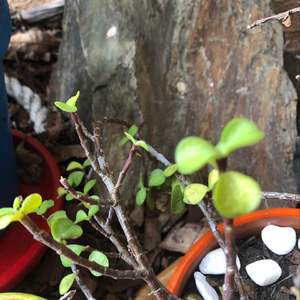

0
0
文章
Miss Chen
2018年07月06日

Carrots are a root vegetable. This means that humans typically only eat the orange edible taproot--main plant root--and not the edible leafy greens that are above ground. Carrots are not part of the typical annual--one year--or perennial--many repetitive years--plant cycles. Carrots are actually classified as biennials, according to the World Carrot Museum.

What is a Biennial?
Wet Carrots in the dirt
credit: HandmadePictures/iStock/Getty Images
Biennials like carrots live for two growing seasons before the completion of their life cycle, according to the University of Illinois Extension. Biennial plants grow vegetatively--produce leaves--for the first season of life. After a period of dormancy--rest without growth--following the first season of growth biennials resume growth for a second season, flower, seed and die.
Germination

Carrot plants produce seeds during the second season of biennial growth. Pollen is produced and delivered to the stigma, according to the WCM. The plant then produces seed. Carrot seeds are exceptionally small: 2000 seeds can fit in a single teaspoon. Carrot seeds take 10-12 days to germinate and begin growth.
Growth

Carrots will grow leafy green shoots from the taproot. These shoots are where flowering happens during the second season of growth. Carrots are usually prime for harvesting within three months, states the WCM; however, carrots can and frequently are harvested early. Baby carrots are merely immature carrots, but baby-cut carrots are mature carrots shaved to baby size.
Dormancy

The period of carrot dormancy between seasons is typically winter in most areas the carrot is cultivated. Carrots growth is essentially complete when it enters dormancy, and flowering may not happen if dormant states experience interruption from unseasonably warm winters or late frosts. Carrots need a dormant state to prepare for the reproduction period.
Carrot Variants

Carrots are available in a variety of cultivars--varieties human-cultivated for different traits--that produce different shapes and colors of carrots. Some carrots--such as Thumbelinas--are very short and some--such as White Fodder--are not orange in color, according to the WCM. Many colors and shapes of carrot cultivars are available to discernible growers seeking particular carrot results.

What is a Biennial?
Wet Carrots in the dirt
credit: HandmadePictures/iStock/Getty Images
Biennials like carrots live for two growing seasons before the completion of their life cycle, according to the University of Illinois Extension. Biennial plants grow vegetatively--produce leaves--for the first season of life. After a period of dormancy--rest without growth--following the first season of growth biennials resume growth for a second season, flower, seed and die.
Germination

Carrot plants produce seeds during the second season of biennial growth. Pollen is produced and delivered to the stigma, according to the WCM. The plant then produces seed. Carrot seeds are exceptionally small: 2000 seeds can fit in a single teaspoon. Carrot seeds take 10-12 days to germinate and begin growth.
Growth

Carrots will grow leafy green shoots from the taproot. These shoots are where flowering happens during the second season of growth. Carrots are usually prime for harvesting within three months, states the WCM; however, carrots can and frequently are harvested early. Baby carrots are merely immature carrots, but baby-cut carrots are mature carrots shaved to baby size.
Dormancy

The period of carrot dormancy between seasons is typically winter in most areas the carrot is cultivated. Carrots growth is essentially complete when it enters dormancy, and flowering may not happen if dormant states experience interruption from unseasonably warm winters or late frosts. Carrots need a dormant state to prepare for the reproduction period.
Carrot Variants

Carrots are available in a variety of cultivars--varieties human-cultivated for different traits--that produce different shapes and colors of carrots. Some carrots--such as Thumbelinas--are very short and some--such as White Fodder--are not orange in color, according to the WCM. Many colors and shapes of carrot cultivars are available to discernible growers seeking particular carrot results.
1
0
文章
Miss Chen
2018年07月06日

Okra, also known as gumbo, is a warm-weather vegetable that thrives in the long, hot summers of the southern United States. Although okra loves hot weather, it can successfully be grown in cooler Northern climates as well. Plant okra seeds directly in your garden seven to 10 days after the last expected frost in your area, as the seeds won't grow in cold weather. Okra will be ready to harvest approximately 60 days after planting.

Step 1
Spade the soil in a sunny area in your garden. Work the soil to a depth of at least 6 inches, then work in an all-purpose granular fertilizer with a ratio such as 10-10-10. Apply 1 to 2 lbs. of fertilizer for every 100 square feet of garden space.
Step 2
Make shallow rows with the corner of your hoe. Allow 3 feet between each row. Plant the okra seeds 4 to 6 inches apart in the rows, then cover the seeds with 1 inch of soil. Water lightly with a hose and spray attachment.
Step 3
Thin the okra seedlings when the plants are 2 to 4 inches tall. Allow 12 to 18 inches between each plant.
Step 4
Water okra deeply enough to saturate the soil once every seven to 10 days during extended hot, dry periods. Otherwise, okra requires no irrigation.

Step 5
Harvest okra with kitchen shears or a sharp knife when the pods are 2 to 4 inches long. Okra ripens quickly in late summer so check the plants every two to three days. Handle the pods gently as okra is tender and bruises easily. Pick regularly, as the plant will go to seed and won't continue to produce if the pods are allowed to remain on the plant.

Step 1
Spade the soil in a sunny area in your garden. Work the soil to a depth of at least 6 inches, then work in an all-purpose granular fertilizer with a ratio such as 10-10-10. Apply 1 to 2 lbs. of fertilizer for every 100 square feet of garden space.
Step 2
Make shallow rows with the corner of your hoe. Allow 3 feet between each row. Plant the okra seeds 4 to 6 inches apart in the rows, then cover the seeds with 1 inch of soil. Water lightly with a hose and spray attachment.
Step 3
Thin the okra seedlings when the plants are 2 to 4 inches tall. Allow 12 to 18 inches between each plant.
Step 4
Water okra deeply enough to saturate the soil once every seven to 10 days during extended hot, dry periods. Otherwise, okra requires no irrigation.

Step 5
Harvest okra with kitchen shears or a sharp knife when the pods are 2 to 4 inches long. Okra ripens quickly in late summer so check the plants every two to three days. Handle the pods gently as okra is tender and bruises easily. Pick regularly, as the plant will go to seed and won't continue to produce if the pods are allowed to remain on the plant.
1
0
成长记
Pommy Mommy
2018年07月04日

I'm just shocked that I have ANY blooms on this plant since I only planted it in the ground last September
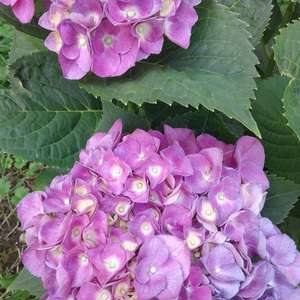
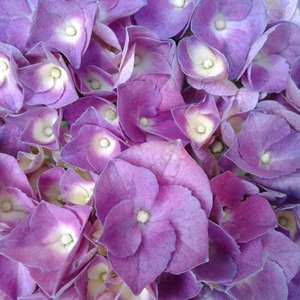
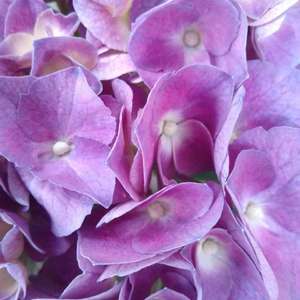
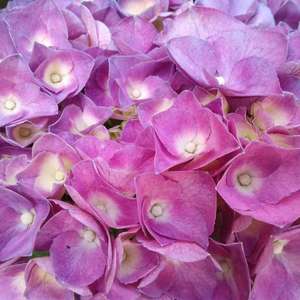
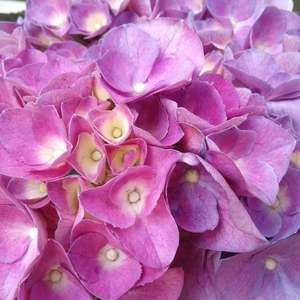
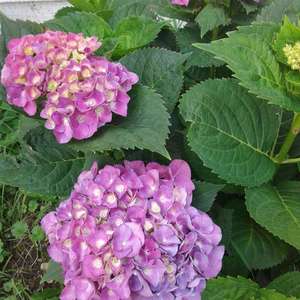
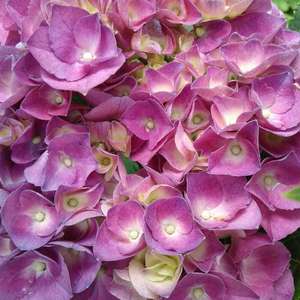
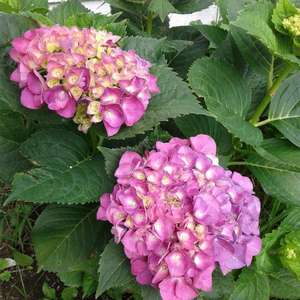
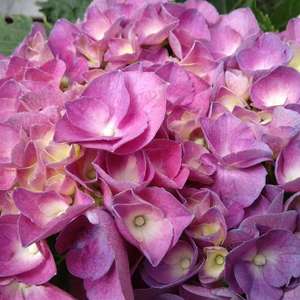









1
0
文章
Miss Chen
2018年07月03日

Description: This plant is a summer annual about ½–2' tall that is either unbranched or occasionally branched. The stems are light to medium green, terete, and moderately covered with a combination of spreading hairs, curved hairs, and short pubescence. The alternate leaves are more closely spaced together toward the apex of the plant rather than the bottom, providing it with a flat-topped appearance. The leaf blades are up to 3" long and 1" across; they are medium green, lanceolate, and crenate with widely spaced blunt teeth to nearly smooth. The upper surfaces of the blades are sparsely canescent, sparsely covered with appressed hairs, or hairless. The slender petioles are up to 1" long; they are about one-third the length of their blades and usually short-pubescent.
Virginia Mercury is monoecious, bearing both staminate (male) and pistillate (female) flowers on the same plant. Both male and female flowers develop within the same foliaceous bracts from the axils of the leaves. These bracts are sessile (or nearly so), up to ½" tall, and a little more across; they are either open or loosely folded around the flowers. Individual bracts are medium green, more or less hairy, palmately lobed (10-15 lobes), and ciliate along their margins. Individual lobes are linear-lanceolate. Within each bract, a spike of staminate flowers develops. At maturity, each spike is up to ¾" long. Each staminate flower is less than 1/8" (3 mm.) across, consisting of a 4-lobed calyx, no petals, and several stamens. The staminate flowers are densely packed along the upper half of each spike. Within the same bract, there are 1-3 sessile pistillate flowers that are largely hidden from view. Each pistillate flower is about ¼" across, consisting of insignificant sepals, no petals, and a 3-valved globoid ovary with short divided styles. The blooming period occurs from mid-summer into the fall and lasts about 2-3 months. Only a few flowers are in bloom at the same time. Cross-pollination is by wind. Each pistillate flower matures into a 3-celled seed capsule; each cell of the capsule contains a single ovoid-oblongoid seed about 1-2 mm. long. This plant reproduces by reseeding itself.
Cultivation: The preference is partial sun, mesic conditions, and a fertile loam, although other soil types are tolerated. Most growth and development occurs during the summer and early fall.

Range & Habitat: The native Virginia Mercury is occasional to locally common in the southern half of Illinois, becoming uncommon in the northern half of the state (see Distribution Map). Habitats include disturbed open woodlands, rocky woodlands, thinly wooded bluffs, woodland borders, thickets, disturbed areas of prairies and weedy meadows, partially-shaded gravelly seeps, cropland and abandoned fields, areas along railroads and roadsides, flower gardens underneath trees, and areas adjacent to the foundations of buildings. This plant has low fidelity to any particular habitat.
Faunal Associations: The flea beetles Hornaltica bicolorata and Margaridisa atriventris feed on Acalypha spp. The Mourning Dove, Swamp Sparrow, and possibly other birds eat the seeds, while White-Tailed Deer browse on the foliage, primarily during the summer and fall. Virginia Mercury lacks the toxic white latex that is a typical characteristic of other species in the Spurge family (Euphorbiaceae).
Photographic Location: A flower garden underneath a tree in downtown Urbana, Illinois.

Comments: Virginia Mercury is somewhat weedy, although it is less aggressive and common than Acalypha rhomboidea (Rhomboid Mercury). In the past, Rhomboid Mercury and Acalypha deamii (Deam's Mercury) were considered varieties of Virginia Mercury, but they are now regarded as distinct species. Virginia Mercury differs from these latter two species by its more hairy stems, more narrow leaves, more numerous lobes (10-15) on its foliaceous bracts, and slightly longer staminate spikes that are exerted beyond the lobes of the bracts. Another species, Acalypha graciliens (Slender Mercury), has even more slender leaves than Virginia Mercury and its petioles are shorter (about one-fourth the length of its leaves). Slender Mercury usually has longer staminate spikes (at least 1" long), although there is an uncommon variety (var. monococca) that has staminate spikes about the same length as Virginia Mercury. Individual seed capsules of Acalypha graciliens var. monococca have one seed each, while seed capsules of Virginia Mercury have 3 seeds each. Another common name of Acalypha virginica is Virginia Copperleaf.
Virginia Mercury is monoecious, bearing both staminate (male) and pistillate (female) flowers on the same plant. Both male and female flowers develop within the same foliaceous bracts from the axils of the leaves. These bracts are sessile (or nearly so), up to ½" tall, and a little more across; they are either open or loosely folded around the flowers. Individual bracts are medium green, more or less hairy, palmately lobed (10-15 lobes), and ciliate along their margins. Individual lobes are linear-lanceolate. Within each bract, a spike of staminate flowers develops. At maturity, each spike is up to ¾" long. Each staminate flower is less than 1/8" (3 mm.) across, consisting of a 4-lobed calyx, no petals, and several stamens. The staminate flowers are densely packed along the upper half of each spike. Within the same bract, there are 1-3 sessile pistillate flowers that are largely hidden from view. Each pistillate flower is about ¼" across, consisting of insignificant sepals, no petals, and a 3-valved globoid ovary with short divided styles. The blooming period occurs from mid-summer into the fall and lasts about 2-3 months. Only a few flowers are in bloom at the same time. Cross-pollination is by wind. Each pistillate flower matures into a 3-celled seed capsule; each cell of the capsule contains a single ovoid-oblongoid seed about 1-2 mm. long. This plant reproduces by reseeding itself.
Cultivation: The preference is partial sun, mesic conditions, and a fertile loam, although other soil types are tolerated. Most growth and development occurs during the summer and early fall.

Range & Habitat: The native Virginia Mercury is occasional to locally common in the southern half of Illinois, becoming uncommon in the northern half of the state (see Distribution Map). Habitats include disturbed open woodlands, rocky woodlands, thinly wooded bluffs, woodland borders, thickets, disturbed areas of prairies and weedy meadows, partially-shaded gravelly seeps, cropland and abandoned fields, areas along railroads and roadsides, flower gardens underneath trees, and areas adjacent to the foundations of buildings. This plant has low fidelity to any particular habitat.
Faunal Associations: The flea beetles Hornaltica bicolorata and Margaridisa atriventris feed on Acalypha spp. The Mourning Dove, Swamp Sparrow, and possibly other birds eat the seeds, while White-Tailed Deer browse on the foliage, primarily during the summer and fall. Virginia Mercury lacks the toxic white latex that is a typical characteristic of other species in the Spurge family (Euphorbiaceae).
Photographic Location: A flower garden underneath a tree in downtown Urbana, Illinois.

Comments: Virginia Mercury is somewhat weedy, although it is less aggressive and common than Acalypha rhomboidea (Rhomboid Mercury). In the past, Rhomboid Mercury and Acalypha deamii (Deam's Mercury) were considered varieties of Virginia Mercury, but they are now regarded as distinct species. Virginia Mercury differs from these latter two species by its more hairy stems, more narrow leaves, more numerous lobes (10-15) on its foliaceous bracts, and slightly longer staminate spikes that are exerted beyond the lobes of the bracts. Another species, Acalypha graciliens (Slender Mercury), has even more slender leaves than Virginia Mercury and its petioles are shorter (about one-fourth the length of its leaves). Slender Mercury usually has longer staminate spikes (at least 1" long), although there is an uncommon variety (var. monococca) that has staminate spikes about the same length as Virginia Mercury. Individual seed capsules of Acalypha graciliens var. monococca have one seed each, while seed capsules of Virginia Mercury have 3 seeds each. Another common name of Acalypha virginica is Virginia Copperleaf.
0
0
文章
Miss Chen
2018年07月03日

Description: This annual plant is ½–2' tall, and usually unbranched. The central stem has lines of fine white hairs, or is glabrous. The alternate leaves are up to 3½" long and 1" across, with long narrow petioles that are slightly hairy. They are lanceolate or ovate, with bluntly serrated margins and conspicuous pinnate venation. There is a tendency for the leaves to congregate together near the top of the central stem, or any side stems that may be present. Where the petiole of each leaf meets the stem, there is a conspicuous bract that wraps around the inflorescence consisting of a green cyathium. This bract is slightly ciliate along the edges, and has 5-9 lobes. The cyathium contains tiny staminate and pistillate flowers without sepals and petals. The staminate flower is covered with yellow pollen, while the pistillate flower produces a 3-lobed spheroid fruit that is typical of the spurges. Each fruit contains three seeds. The blooming period occurs from about mid-summer until frost during the fall, and lasts one or more months. There is no floral scent. The root system consists of a central taproot.
Cultivation: The preference is light shade to full sun, and moist to slightly dry conditions. This plant often grows in fertile, loamy soil, but can tolerate gravelly or clay soil as well. This plant is easy and undemanding, and may volunteer spontaneously in a wildflower garden or ecological restoration. However, it is rather common and weedy.
Range & Habitat: The native Rhomboid Mercury occurs in every county of Illinois, and it is quite common (see Distribution Map). This is a rather inconspicuous plant that is easily overlooked because of the lack of showy flowers. Habitats include disturbed areas of moist prairies, limestone glades, openings or lightly shaded areas of floodplain forests, thickets, seeps, stream banks, ditches, fields, fence rows, roadsides, areas along railroads, vacant lots, poorly maintained lawns and gardens, and waste areas. This plant prefers moist disturbed areas.
Faunal Associations: Like other members of the Spurge family that occur in Illinois, the seeds are attractive to such birds as the Mourning Dove and Greater Prairie Chicken; they may also be attractive to the Bobwhite, Horned Lark, and Wild Turkey. The herbaceous Acalypha spp. in Illinois lack the poisonous white latex of other members in the Spurge family, and their foliage is probably less toxic as a result. Deer are known to browse on Acalypha spp. occasionally, and it is possible that other mammalian herbivores do this as well. There have been reports of cattle being poisoned by these plants, possibly because of accumulation of nitrates in the foliage. It is unclear to me if the flowers of Acalypha spp. are wind- or insect-pollinated, although I suspect the former.

Photographic Location: The photographs were taken in a front yard along a roadside near Urbana, Illinois.
Comments: There are several Acalypha spp. in Illinois; the number of seeds per fruit can range from 1 to 3 (usually the latter), depending on the species. The species described here, Acalypha rhomboidea, is very similar to Acalypha virginica, except that the latter has 9-15 lobes in the bract that surrounds the inflorescence at the base of the petiole. Some authorities consider the former species to be merely a variety of the latter. The foliage of Acalypha spp. often becomes purplish tan during the fall, which has inspired the common name, 'Copperleaf.' This common name is often used in the agricultural industry.
Cultivation: The preference is light shade to full sun, and moist to slightly dry conditions. This plant often grows in fertile, loamy soil, but can tolerate gravelly or clay soil as well. This plant is easy and undemanding, and may volunteer spontaneously in a wildflower garden or ecological restoration. However, it is rather common and weedy.
Range & Habitat: The native Rhomboid Mercury occurs in every county of Illinois, and it is quite common (see Distribution Map). This is a rather inconspicuous plant that is easily overlooked because of the lack of showy flowers. Habitats include disturbed areas of moist prairies, limestone glades, openings or lightly shaded areas of floodplain forests, thickets, seeps, stream banks, ditches, fields, fence rows, roadsides, areas along railroads, vacant lots, poorly maintained lawns and gardens, and waste areas. This plant prefers moist disturbed areas.
Faunal Associations: Like other members of the Spurge family that occur in Illinois, the seeds are attractive to such birds as the Mourning Dove and Greater Prairie Chicken; they may also be attractive to the Bobwhite, Horned Lark, and Wild Turkey. The herbaceous Acalypha spp. in Illinois lack the poisonous white latex of other members in the Spurge family, and their foliage is probably less toxic as a result. Deer are known to browse on Acalypha spp. occasionally, and it is possible that other mammalian herbivores do this as well. There have been reports of cattle being poisoned by these plants, possibly because of accumulation of nitrates in the foliage. It is unclear to me if the flowers of Acalypha spp. are wind- or insect-pollinated, although I suspect the former.

Photographic Location: The photographs were taken in a front yard along a roadside near Urbana, Illinois.
Comments: There are several Acalypha spp. in Illinois; the number of seeds per fruit can range from 1 to 3 (usually the latter), depending on the species. The species described here, Acalypha rhomboidea, is very similar to Acalypha virginica, except that the latter has 9-15 lobes in the bract that surrounds the inflorescence at the base of the petiole. Some authorities consider the former species to be merely a variety of the latter. The foliage of Acalypha spp. often becomes purplish tan during the fall, which has inspired the common name, 'Copperleaf.' This common name is often used in the agricultural industry.
0
0
文章
Miss Chen
2018年07月03日

Description: This plant is a summer annual about 1–2½' tall, branching occasionally. The stems are terete or somewhat angular and they have spreading white hairs. The alternate leaves are up to 4" long and 2½" across. They are rather thin-textured and have raised veins on their undersides. The leaves are medium green, cordate or broadly ovate, and serrated along their margins. The long slender petioles often have spreading hairs like the stems. Hornbeam Mercury is monoecious with separate male and female flowers on the same plant. The male (staminate) flowers develop from the axils of the leaves in non-terminal spikes about ½–2" long. These cylindrical spikes are densely crowded with small flowers. Each male flower is about 1/8" (3 mm.) across, consisting of 4 sepals that are green or translucent white, several stamens that are white, and no petals. The spikes of female (pistillate) flowers terminate the upper stems; they are usually located above the male flowers. The pistillate spikes are also densely crowded with small flowers, but their appearance is less smooth and cylindrical than the staminate spikes because of the long styles and floral bracts. Each female flower is about ¼" across, consisting of several long branching styles that are white, a green ovary that is quite spiny in appearance, and no petals. At the base of each female flower, there is a surrounding floral bract with several narrow lobes. The blooming period occurs from mid-summer to early fall and lasts about 1-2 months. The flowers are cross-pollinated by the wind. Afterwards, the female flowers are replaced by 3-valved seed capsules; each valve of a capsule contains a single seed. The seeds are ovoid in shape, broader and rounder at one end than the other, and pitted or wrinkled across the surface. The root system consists of a taproot. This plant spreads by reseeding itself, and occasionally forms colonies.

Cultivation: This plant is typically found in full or partial sun, moist to mesic conditions, and a fertile loamy soil. It also occurs in clay-loam and stony soil. At locations that are too hot and dry, the foliage often wilts.
Range & Habitat: The native Hornbeam Mercury occurs occasionally in the southern half of Illinois (see Distribution Map). Habitats include thickets, riverbanks, lower slopes of bluffs, cropland, fallow fields, gardens, areas along buildings, and roadsides. This native species prefers disturbed areas and it is a minor pest of cropland in the southern half of the state.
Faunal Associations: The flowers don't attract many insects because they are wind-pollinated. Two flea beetles, Hornaltica bicolorata and Margaridisa atriventris, feed on Acalypha spp. The seeds are occasionally eaten by the Mourning Dove and probably other granivorous birds. Deer browse on the foliage of these plants, and possibly other mammalian herbivores do this as well. The foliage may be mildly toxic to cattle because of excess nitrate accumulation. Unlike many other members of the Spurge family, the native Acalypha spp. lack a toxic white latex in their foliage.
Photographic Location: A few plants were growing along the foundation of the webmaster's apartment complex in Urbana, Illinois.
Comments: Hornbeam Mercury is a nondescript plant that is easily overlooked. Its leaves are supposed to resemble the leaves of hornbeam trees (e.g., Ostrya spp.), hence the common name. Another common name is Rough-Podded Copperleaf, which refers to the spiny-looking seed capsules and the tendency of the foliage to turn reddish brown during the fall. Hornbeam Mercury differs from other native Acalypha spp. by its monoecious flowers (separate spikes of male and female flowers) and its broad serrated leaves that are heart-shaped (cordate) at the base. The leaves remind me of the foliage of woodland plants in the Nettle family, but Hornbeam Mercury occurs in sunnier habitats and the female flowers are surrounded by the lobed bracts that are typical of native Acalypha spp. in Illinois.

Cultivation: This plant is typically found in full or partial sun, moist to mesic conditions, and a fertile loamy soil. It also occurs in clay-loam and stony soil. At locations that are too hot and dry, the foliage often wilts.
Range & Habitat: The native Hornbeam Mercury occurs occasionally in the southern half of Illinois (see Distribution Map). Habitats include thickets, riverbanks, lower slopes of bluffs, cropland, fallow fields, gardens, areas along buildings, and roadsides. This native species prefers disturbed areas and it is a minor pest of cropland in the southern half of the state.
Faunal Associations: The flowers don't attract many insects because they are wind-pollinated. Two flea beetles, Hornaltica bicolorata and Margaridisa atriventris, feed on Acalypha spp. The seeds are occasionally eaten by the Mourning Dove and probably other granivorous birds. Deer browse on the foliage of these plants, and possibly other mammalian herbivores do this as well. The foliage may be mildly toxic to cattle because of excess nitrate accumulation. Unlike many other members of the Spurge family, the native Acalypha spp. lack a toxic white latex in their foliage.
Photographic Location: A few plants were growing along the foundation of the webmaster's apartment complex in Urbana, Illinois.
Comments: Hornbeam Mercury is a nondescript plant that is easily overlooked. Its leaves are supposed to resemble the leaves of hornbeam trees (e.g., Ostrya spp.), hence the common name. Another common name is Rough-Podded Copperleaf, which refers to the spiny-looking seed capsules and the tendency of the foliage to turn reddish brown during the fall. Hornbeam Mercury differs from other native Acalypha spp. by its monoecious flowers (separate spikes of male and female flowers) and its broad serrated leaves that are heart-shaped (cordate) at the base. The leaves remind me of the foliage of woodland plants in the Nettle family, but Hornbeam Mercury occurs in sunnier habitats and the female flowers are surrounded by the lobed bracts that are typical of native Acalypha spp. in Illinois.
0
0
文章
Miss Chen
2018年07月03日

Description: This plant is a summer annual about 2-7' tall that branches occasionally. The stems are terete (circular in cross-section), and pubescent. The alternate leaves are up to 8" long and across (excluding the petioles). They are cordate or orbicular-cordate, slightly dentate along their margins, and more or less pubescent. The primary veins of the leaves are arranged palmately. The petioles are up to 4" long and pubescent as well. The foliage of the entire plant is mostly light green, although the upper surfaces of the leaves are dull green.
From the axils of the upper leaves, there occasionally develops a single flower about ¾" across. It consists of 5 petals that are orange-yellow or yellow, 5 sepals that are pubescent and light green, and numerous stamens with golden yellow anthers that surround the pistil in a loose cluster. The flowering stalk of each flower is about 1" long, which is much shorter than the petioles of the leaves. The blooming period usually occurs from late summer to early fall, and lasts about 1-2 months. The flowers are sparingly produced and short-lived. Each flower is replaced by a fruit about ¾" across. It is initially light green, but rather quickly turns brown or black with maturity. This fruit consists of a ring of about 10-15 flattened seedpods. Each seedpod has a stout beak and contains about 5-15 seeds. Each seed is greyish brown, somewhat flattened, and either reniform (kidney-shaped) or cordate (heart-shaped). The root system consists of a stout white taproot. This plant spreads by reseeding itself.
Cultivation: Velvetleaf is typically found in full sun, mesic conditions, and a fertile soil consisting of loam or clay-loam. The fertility of the soil, particularly the level of nitrogen, has a strong influence on the size of the plant. The seeds can remain viable in the soil for at least 20 years, if not considerably longer.

Range & Habitat: This is a common non-native plant that occurs in most counties of Illinois (see Distribution Map). Habitats include cropland (particularly corn and soybean fields), abandoned fields, vacant lots, construction sites, and waste areas. Velvetleaf typically occurs where the soil has been recently disturbed and the long dormant seeds are brought close to the soil surface. The seeds germinate during warm weather after the spring tilling of fields, and the new generation of plants develops and matures very quickly during the heat of summer, prior to the fall harvest. As a result, Velvetleaf is a major weed of cropland in Illinois. It was introduced into the United States from India as a possible source of bast.
Faunal Associations: The nectar and pollen of the flowers attract various kinds of bees, including bumblebees, long-horned bees (Melissodes spp.), leaf-cutting bees (Megachile spp.), and Halictid bees. Occasionally, small- to medium-sized butterflies visit the flowers for nectar, while Syrphid flies feed on the pollen (Robertson, 1929). Some insects feed destructively on Velvet Leaf. Insects that feed on either the mature or developing seeds include Amara aenea (Common Sun Beetle), Anisodactylus sanctaecrucis (a ground beetle), Harpalus pensylvanicus (Pennsylvania Ground Beetle), Gryllus pennsylvanicus (Fall Field Cricket), larvae of Althaeus folkertsi (Velvetleaf Seed Beetle), Liorhyssus hyalinus (Hyaline Grass Bug), Niesthrea louisianica (Louisiana Hibiscus Bug), larvae of Helicoverpa zea (Corn Earworm Moth), and larvae of Heliothis virescens (Tobacco Budworm Moth); see White et al. (2007), Lundgren & Rosentrater (2007), and Gibb (1991). Some of these insects also feed on the flowers and their buds. The larvae of Calycomyza malvae (a leaf-miner fly) tunnel through the leaves, while Ophiomyia abutilivora (a leaf-miner fly) bore through the stems of Velvet Leaf (Spencer & Steyskal, 1986). The larvae of Pyrgus communis (Checkered Skipper) make folded-leaf nests, from which they feed (Barnes, 1999).

Photographic Location: A vacant lot in Urbana, Illinois. There is a small black bee visiting the flower in one of the photographs.
Comments: Velvetleaf is a rather tall and lanky plant with large leaves that is easy to identify in the field because there is really nothing else that resembles it. There are other weedy members of the Mallow family that have been introduced from abroad, but they are much smaller plants. Velvetleaf is about as tall as the native Hibiscus spp. (Rose Mallows), but the latter are perennials with darker foliage and much larger flowers. The seeds of Velvetleaf are reportedly edible. In an outdoor emergency, the soft leaves can be used as a substitute for toilet paper.
From the axils of the upper leaves, there occasionally develops a single flower about ¾" across. It consists of 5 petals that are orange-yellow or yellow, 5 sepals that are pubescent and light green, and numerous stamens with golden yellow anthers that surround the pistil in a loose cluster. The flowering stalk of each flower is about 1" long, which is much shorter than the petioles of the leaves. The blooming period usually occurs from late summer to early fall, and lasts about 1-2 months. The flowers are sparingly produced and short-lived. Each flower is replaced by a fruit about ¾" across. It is initially light green, but rather quickly turns brown or black with maturity. This fruit consists of a ring of about 10-15 flattened seedpods. Each seedpod has a stout beak and contains about 5-15 seeds. Each seed is greyish brown, somewhat flattened, and either reniform (kidney-shaped) or cordate (heart-shaped). The root system consists of a stout white taproot. This plant spreads by reseeding itself.
Cultivation: Velvetleaf is typically found in full sun, mesic conditions, and a fertile soil consisting of loam or clay-loam. The fertility of the soil, particularly the level of nitrogen, has a strong influence on the size of the plant. The seeds can remain viable in the soil for at least 20 years, if not considerably longer.

Range & Habitat: This is a common non-native plant that occurs in most counties of Illinois (see Distribution Map). Habitats include cropland (particularly corn and soybean fields), abandoned fields, vacant lots, construction sites, and waste areas. Velvetleaf typically occurs where the soil has been recently disturbed and the long dormant seeds are brought close to the soil surface. The seeds germinate during warm weather after the spring tilling of fields, and the new generation of plants develops and matures very quickly during the heat of summer, prior to the fall harvest. As a result, Velvetleaf is a major weed of cropland in Illinois. It was introduced into the United States from India as a possible source of bast.
Faunal Associations: The nectar and pollen of the flowers attract various kinds of bees, including bumblebees, long-horned bees (Melissodes spp.), leaf-cutting bees (Megachile spp.), and Halictid bees. Occasionally, small- to medium-sized butterflies visit the flowers for nectar, while Syrphid flies feed on the pollen (Robertson, 1929). Some insects feed destructively on Velvet Leaf. Insects that feed on either the mature or developing seeds include Amara aenea (Common Sun Beetle), Anisodactylus sanctaecrucis (a ground beetle), Harpalus pensylvanicus (Pennsylvania Ground Beetle), Gryllus pennsylvanicus (Fall Field Cricket), larvae of Althaeus folkertsi (Velvetleaf Seed Beetle), Liorhyssus hyalinus (Hyaline Grass Bug), Niesthrea louisianica (Louisiana Hibiscus Bug), larvae of Helicoverpa zea (Corn Earworm Moth), and larvae of Heliothis virescens (Tobacco Budworm Moth); see White et al. (2007), Lundgren & Rosentrater (2007), and Gibb (1991). Some of these insects also feed on the flowers and their buds. The larvae of Calycomyza malvae (a leaf-miner fly) tunnel through the leaves, while Ophiomyia abutilivora (a leaf-miner fly) bore through the stems of Velvet Leaf (Spencer & Steyskal, 1986). The larvae of Pyrgus communis (Checkered Skipper) make folded-leaf nests, from which they feed (Barnes, 1999).

Photographic Location: A vacant lot in Urbana, Illinois. There is a small black bee visiting the flower in one of the photographs.
Comments: Velvetleaf is a rather tall and lanky plant with large leaves that is easy to identify in the field because there is really nothing else that resembles it. There are other weedy members of the Mallow family that have been introduced from abroad, but they are much smaller plants. Velvetleaf is about as tall as the native Hibiscus spp. (Rose Mallows), but the latter are perennials with darker foliage and much larger flowers. The seeds of Velvetleaf are reportedly edible. In an outdoor emergency, the soft leaves can be used as a substitute for toilet paper.
0
0





